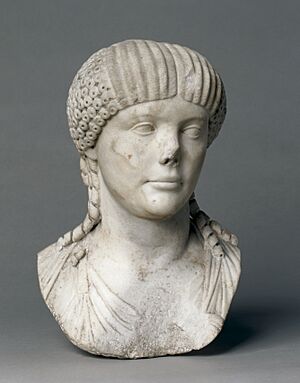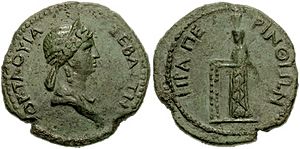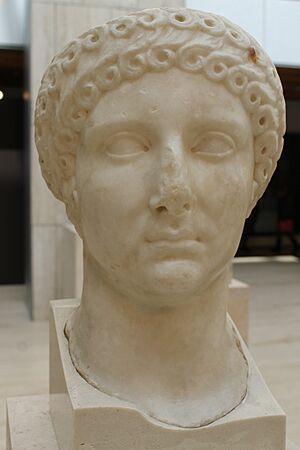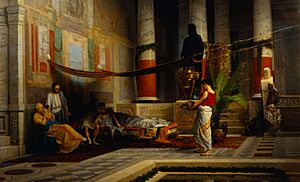Claudia Octavia facts for kids
Quick facts for kids Claudia Octavia |
|
|---|---|

Portrait head of Claudia Octavia, National Museum of Rome
|
|
| Roman empress | |
| Tenure | October 13, AD 54 – June 9, AD 62 |
| Born | late AD 39/early AD 40 Rome |
| Died | June 9, AD 62 (aged c. 22) Pandateria |
| Spouse | Nero |
| House | Julio-Claudian |
| Father | Claudius |
| Mother | Valeria Messalina |
Claudia Octavia (born in late 39 or early 40 AD – died June 9, AD 62) was a Roman empress. She was the daughter of the Roman Emperor Claudius and his wife, Valeria Messalina.
After her mother passed away, her father married again. His new wife was Octavia's cousin, Agrippina the Younger. This made Octavia the stepsister of the future Emperor Nero. Agrippina arranged for Octavia and Nero to get married.
Octavia was very popular with the Roman people. However, Nero did not like their marriage. When his girlfriend, Poppaea Sabina, became pregnant, Nero divorced Octavia and sent her away. This made the public very angry. Because of the public's reaction, Nero had Octavia killed.
Contents
Octavia's Early Life
Her Family
Octavia was the older of two children born to Claudius and his third wife, Valeria Messalina. Her younger brother was named Britannicus.
She also had older half-sisters and half-brothers from her father's earlier marriages. Her older half-sister was Claudia Antonia. Octavia was named after her great-grandmother, Octavia the Younger. This Octavia was the sister of the famous Emperor Augustus.
Growing Up in Rome
Octavia was born in Rome around 39 or 40 AD. At that time, her cousin Caligula was the emperor. In January 41 AD, Caligula was killed. Soon after, her father, Claudius, became the new emperor.
That same year, Octavia's brother Britannicus was born. Also in 41 AD, Claudius arranged for Octavia to be engaged to Lucius Junius Silanus Torquatus. He was a relative of Emperor Augustus.
In 48 AD, Octavia's mother, Messalina, faced serious trouble. She was accused of trying to take over the empire. Claudius was told about this and quickly returned to Rome. Octavia and Britannicus were sent to meet Claudius to try and calm his anger. Messalina's efforts to make things right failed, and she was put to death.
Claudius Remarries and Nero Rises
After Messalina's death, Claudius needed to remarry. This was important for political reasons. In 49 AD, Claudius married Agrippina the Younger. She was the daughter of a popular general named Germanicus. Agrippina was also Claudius's niece and Octavia's first cousin. The law was even changed to allow this marriage.
Agrippina had a son named Lucius Domitius Ahenobarbus from her first marriage. In 50 AD, Claudius adopted Lucius. His name then changed to Nero Claudius Caesar Drusus Germanicus. Agrippina was very involved in politics and had a lot of influence over Claudius.
Life as Empress
On October 13, 54 AD, Emperor Claudius became sick and died suddenly. Many people suspected that Agrippina had poisoned him. This was because Claudius's death happened at a convenient time for Nero. Octavia's brother, Britannicus, was growing up quickly and might have become emperor instead of Nero.
On the same day Claudius died, Nero was declared emperor. Octavia was now married to the new emperor of Rome. After Nero became emperor, his relationship with his mother, Agrippina, started to get worse. They both wanted power.
The next year, Britannicus also died during a dinner. Octavia, Nero, and Agrippina were all there. Octavia and Agrippina were shocked. Nero said Britannicus had an illness, but many believed Nero had poisoned him. Britannicus was a possible rival to Nero. Octavia learned to hide her feelings during these difficult times.
Octavia and Agrippina became closer after Britannicus died. Nero wanted to marry one of his girlfriends. This caused more arguments between Nero and Agrippina. These arguments ended in March 59 AD when Nero had his mother killed.
The Roman people liked Octavia very much. However, her marriage to Nero was unhappy and without love. Nero had no interest in her. He even said she should be happy just to be his wife in name only.
In 62 AD, Nero's important advisors were gone. One of them, Sextus Afranius Burrus, died. Burrus had told Nero not to divorce Octavia. He said that Octavia's marriage to Nero made Nero a rightful emperor. The same year Burrus died, Nero's girlfriend, Poppaea, became pregnant.
Divorce and Death
Nero divorced Octavia. He claimed she could not have children. Soon after, Nero married Poppaea.
Nero and Poppaea tried to ruin Octavia's good name. They sent her away to a place called Campania. The people of Rome were very upset about Octavia being sent away. There were many public protests against Poppaea. People even cheered when rumors spread that Nero had changed his mind about the divorce. Statues of Octavia were carried through the streets, while statues of Poppaea were pulled down.
Nero was unsure what to do. Poppaea argued that Octavia should be treated even more harshly. She said that any man Octavia might marry could become a threat to Nero's power.
Octavia was then sent to a small island called Pandateria (now Ventotene). Other important Roman women had been sent there before. A few days after she arrived, soldiers came with orders to kill her. She tried to plead with them, but it did not work. She was captured and killed on June 9, 62 AD.
In Stories and Art
Octavia's divorce from Nero is the main topic of a play called Octavia. This play is the only Roman drama based on Roman history that still exists today. It was written by someone unknown after Nero died.
Starting in the 1600s, many operas and plays were made about Nero's life. The play Octavia likely influenced some of these works. Octavia appears in works by famous composers like Claudio Monteverdi and George Frideric Handel.
Octavia is also a character in the novel Claudius the God by Robert Graves. This book was also made into a TV series called I, Claudius. She is also the main character in the historical novel Octavia: A Tale of Ancient Rome by Seymour van Santvoord.
See also
 In Spanish: Octavia para niños
In Spanish: Octavia para niños
- Julio-Claudian family tree






